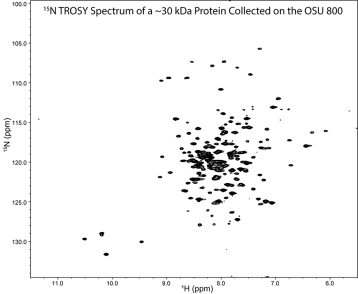Macromolecular Analysis
Macromolecular Analysis
The emergence of biologics as a major class of drugs is leading to the renewed need for characterization of the higher order structure of proteins. High field NMR is proving to be a valuable resource for the study of macromolecular structure and interactions. The OSU NMR Facility is ready to assist our industry partners with the characterization of macromolecular structure and function.
Some of our capabilities:
Image

- Full structure determination. For proteins that can be isotopically labeled with 15N, 13C and 2H (if needed) and are under ~40kD in molecular weight, the OSU NMR Facility can assist with determining the 3D structure of your protein of interest.
- Screening for Ligand Binding. Do you need to know if your ligand binds to a protein target? If so, the OSU NMR Facility can help. Several NMR methods are available to screen for ligand binding. Ligand detected methods, such as Saturation Transfer Difference (STD), do not require high protein concentrations or isotopically labeled protein, making detection of ligand binding relatively easy for NMR. Furthermore, STD-NMR can detect weak binding (mM Kd) making it a useful method for fragment based drug design.
- Characterization of Higher Order Structure (HOS). HOS is a critical quality attribute (CQA) that is emerging as a key indicator for consistent manufacturing of biologics as well as reliably comparing biosimilars. 2D 13C-HSQC NMR of protein methyl groups at natural abundance has recently been shown to provide global characterization of HOS in biologics, including mAbs. NMR based characterization of HOS benefits from high field and high sensitivity, both of which are provided by the OSU 800 MHz spectrometer. If your company needs HOS analysis of your biologic, but doesn't have access to high field NMR, the OSU NMR Facility can help. Our 800 MHz spectrometer can acquire a high quality methyl HSQC on a mAb for HOS characterization in ~12 hours of acquisition time, enabling rapid turnaround for your business needs. If your biologic has a smaller molecular weight or you use immobilized papain to cleave the mAb to a Fab the spectrum can be collected in less time, ~5 hours for a Fab.
All capabilities available based on hourly instrument and staff rates.